This question furthers a previous question. In that question valter provided me with a very good answer that used two lines of code to perform all the math. I'm hoping he would like to try his hand at this problem also. Even though it looks similar I have not been able to get any math to work.
I need to now draw exactly the same annular sectors accept that the OuterRadius in that question becomes a Rectangle. I include this image to explain what I mean. You will notice the red line that represents the Rectangle plugged into the function. The image is actually a screen capture of what the code I tried up to now produces. Naturally most them are is wrong, but the top left annular sector for instance is correct. All the annular sectors should terminate on the rectangle edge, whilst compensating for the gap. Corner cases would probably need 3 points.
I have decided to post the code I have so far, so the puritans must please close their eyes, because it is pretty brutal:
<Extension()> Friend Sub AddAnnularSector(
ByVal aGraphicsPath As GraphicsPath,
ByVal aCenterPoint As PointR,
ByVal aInnerRadius As Double,
ByVal aOuterRectangle As RectangleF,
ByVal aStartAngle As Double,
ByVal aSweepAngle As Double,
ByVal aStartGap As Double,
ByVal aEndGap As Double)
'Declare local variables...
Dim tInnerStartOffset As Double = (Math.Asin(aStartGap / aInnerRadius) * 180.0R) / Math.PI
Dim tInnerEndOffset As Double = (Math.Asin(aEndGap / aInnerRadius) * 180.0R) / Math.PI
Dim tTestAngle1 As Double = aStartAngle + aSweepAngle - tInnerEndOffset
If tTestAngle1 > 360.0R Then tTestAngle1 -= 360.0R
If tTestAngle1 > 270.0R Then tTestAngle1 = 360.0R - tTestAngle1
If tTestAngle1 > 180.0R Then tTestAngle1 -= 180.0R
If tTestAngle1 > 90.0R Then tTestAngle1 = 180.0R - tTestAngle1
Dim tOuterEndLength As Double = (Math.Min(aOuterRectangle.Width, aOuterRectangle.Height) / 2) / Math.Sin(tTestAngle1.ToRadians)
Dim tTestAngle2 As Double = aStartAngle + tInnerStartOffset
If tTestAngle2 > 360.0R Then tTestAngle2 -= 360.0R
If tTestAngle2 > 270.0R Then tTestAngle2 = 360.0R - tTestAngle2
If tTestAngle2 > 180.0R Then tTestAngle2 -= 180.0R
If tTestAngle2 > 90.0R Then tTestAngle2 = 180.0R - tTestAngle2
Dim tOuterStartLength As Double = (Math.Min(aOuterRectangle.Width, aOuterRectangle.Height) / 2) / Math.Sin(tTestAngle2.ToRadians)
'Add the annular sector to the figure...
aGraphicsPath.StartFigure()
aGraphicsPath.AddArc(CSng(aCenterPoint.X - aInnerRadius), CSng(aCenterPoint.Y - aInnerRadius), CSng(aInnerRadius * 2.0R), CSng(aInnerRadius * 2.0R), CSng(aStartAngle + tInnerStartOffset), CSng(aSweepAngle - (tInnerStartOffset + tInnerEndOffset)))
aGraphicsPath.AddLines(New PointF() {
New PointF(CSng((aCenterPoint.X) + (Math.Cos((aStartAngle + aSweepAngle - tInnerEndOffset).ToRadians) * tOuterEndLength)), CSng((aCenterPoint.Y) + (Math.Sin((aStartAngle + aSweepAngle - tInnerEndOffset).ToRadians) * tOuterEndLength))),
New PointF(CSng((aCenterPoint.X) + (Math.Cos((aStartAngle + tInnerStartOffset).ToRadians) * tOuterStartLength)), CSng((aCenterPoint.Y) + (Math.Sin((aStartAngle + tInnerStartOffset).ToRadians) * tOuterStartLength)))
})
aGraphicsPath.CloseFigure()
Return
End Sub
You will notice how OuterRadius of the previous question changed to aOuterRectangle. Also the inner arc is drawn exactly like the previous outer arc was drawn.
EDIT 1: Just chopped the code off a bit to make it more legible.
EDIT 2: Here is an image of what is actually required unlike the above image that just shows the current result.
- Light Cyan - Figure that will actually be added to the GraphicsPath.
- Dark Cyan - The part of the figure that is cut away by the OuterRectangle.
- Green - The OuterRectangle's dimensions including its center point.
- Yellow - The InnerRadius's dimensions including its center point.
- Pink - Figure added in a previous call to the function with different inputs just for reference.
EDIT 3: This image shows what I thought would be a quick mathematical solution.
Thanks
drifter


